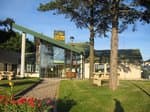The Costes Pathway
This family trail offers you to gaze at the cheese-making village of Roquefort from a perfect but unusual perspective. In the shade of buissières, of hardwood and softwood trees and in the hearth of an agro pastoral landscape, reach the righf bank of the Soulzon brook and discover the village of Roquefort stretching along the Combalou rock side. An unobstructed view to enjoy!
2 points of interest
 Agropastoralism
AgropastoralismA buissière is a protective pathway made of two rows of box trees. In this case, the right side of the first part of the hedge has been removed in order to allow an easier passage. Nevertheless, the remaining hedgerow is still efficient against the prevailing winds. The other side of the buissière is still intact. This means of traversing the Causses is still used, because of the harsh and contrasted climate – very hot in summer and freezing in winter. In the buissière, the sheep flocks are sheltered from wind, snow and heat...
No way to escape from this system of “channels”! People and carts also used to take these pathways for similar reasons. As connections between hamlets, grazing lands, sheepfolds and water ponds, buissières bear witness to the use of the pastoral areas.
Information : Box tree moths are active from May to October. During the caterpillar phase, they feed on the leaves of box trees. They crawl down trees and move on long silken threads, although these threads are annoying when hiking they do not pose any health risk Geology
GeologyNeck de Basalte
In the midst of the Larzac limestone foothills, we can see a homogeneous and easily identifiable green-grey mass in the rock with round shapes called Roque-Nègre. This geological formation running through the ochre-coloured limestone body looks as if it were an old chimney, but is actually an old volcanic vent called a « Neck de Basalte.
Description
- Opposite the Tourist Office, turn to the left and take the trail that runs along the football stadium up to the drinking water tap. When reaching the end of the stadium, leave the trail and turn right on a small path. Walk through the housing estate via a tarmac road. Carry straight ahead up to the large white and green building.
- Leave the building on your right and head to the left to pass behind the municipal workshops, then take left a small shady path. 200 m further on, walk down to the left on a wooden log path up to the intersection of four tracks.
- Turn right and keep on going up to the road, turn left and walk down to the gatekeeper's house. Cautiously cross the railway, then walk uphill to enter a narrow path lined up with hedges.
- Then head towards left on a track following the contour line and enjoy the view over Roquefort and the neck de basalte (old volcanic vent). 1500m further on, at the edge of the woodland, walk above a vineyard and carry straight on.
- When reaching a junction with another trail, appreciate the lovely jasse (sheepfold) in front of you. Turn to the left, walk down to the railway and cross it. Walk across the Soulzon brook and turn left to take the path through the woodland. A few metres further, turn to the right and walk uphill to the road.
- Walk across the road to reach a path which rises throughout the Conteyne woodland up to the Tourist Office.
- Departure : Roquefort Tourist Office
- Arrival : Roquefort Tourist Office
- Towns crossed : Roquefort-sur-Soulzon and Saint-Rome-de-Cernon
Altimetric profile
Recommandations
Box tree months are active from May to October. During the caterpillar phase, they feed on the leaves of box trees. They crawl down trees and move on long silken threads, although these threads are annoying when hiking they do not pose any health risk
Information desks
Avenue de Lauras, 12250 Roquefort/Soulzon
Situated in the Grands Causses Regional Natural Park, the cheese village of Roquefort stretches on the hillside over the famous scree of the Combalou Rock, in southern Larzac. The village is at an elevation of 630 m and has 700 inhabitants.
OPENING PERIODS:
The Tourist Office is open all year round:
- In July and August, Monday to Saturday: 9.30 to 18.30, Sunday: 10.00 to 17.00.
- April, May, June, September, October; Monday to Saturday: 9.30 to 12.15 & 13.00 to 17.30, closed on Sunday.
- January, February, November, December; Monday to Friday: 9.30 to 12.15 & 13.00 to 17.00, closed on Saturday and Sunday.
Transport
Travel by bus or train: http://www.mobimipy.fr/
Carpooling : BlaBlaCar, Rézo Pouce, Covoiturage-libre, Idvroom, LaRoueVerte, Roulez malin
Access and parking
Report a problem or an error
If you have found an error on this page or if you have noticed any problems during your hike, please report them to us here:

